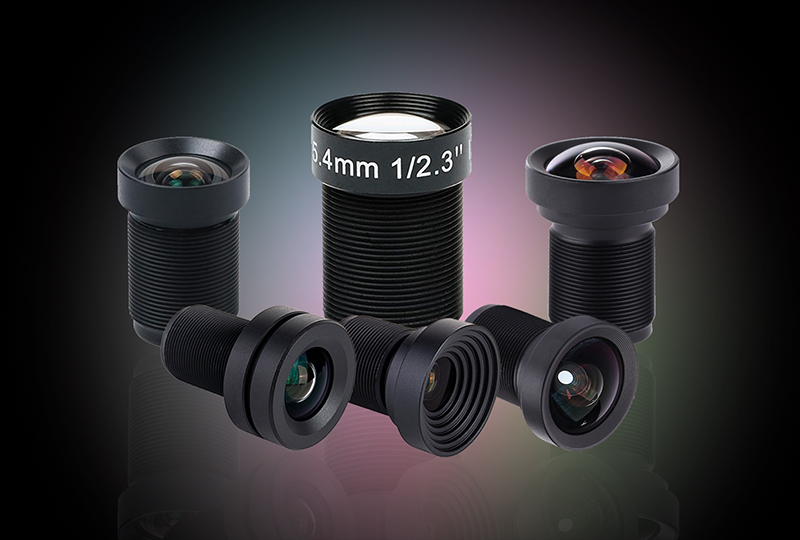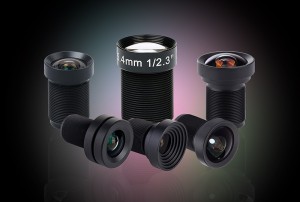|
Model |
CH3664BE |
|||
|
Resolution |
5MP |
Relative Ill. |
>55% |
|
|
Image Format |
1/2″ |
Chief Ray Angle |
<7.4º |
|
|
Image Circle |
ф8.0mm(MAX) |
M.O.D |
0.3m~∞ |
|
|
EFL |
25mm |
Mount Type |
M12*P0.5 |
|
|
TTL |
26.00mm |
Dimension Figure |
ф14.00*L19.42mm |
|
|
F/NO. |
5.6 |
Lens Structure |
4G All Glass |
|
|
FFL(M) |
6.58mm |
IR-Filter |
BP850nm |
|
|
BFL(O) |
11.98mm |
Weight |
5.0g |
|
|
For Sensor |
1/2″ |
Iris Operation |
Fixed |
|
|
F.O.V |
Horizontal |
14.7° |
Zoom Operation |
Fixed |
|
Vertical |
11.1° |
Focus Operation |
Manual |
|
|
Diagonal |
18.3° |
Operating Temperature |
-20° ~+85° |
|
|
TV Distortion |
<-1.13% |
Storage Temperature |
-20° ~+85° |
|
This product was successfully added to cart!
Iris Recognition Lenses
| Model | Sensor Format | Focal Length(mm) | FOV (H*V*D) | TTL(mm) | IR Filter | Aperture | Mount | Unit Price | ||
|---|---|---|---|---|---|---|---|---|---|---|
| MORE+LESS- | CH3664BE | 1/2" | 25 | 14.7º*11.1º*18.3º | 26.00 | BP850nm | 5.6 | M12*P0.5 | $6.0Request Quote |
|
| MORE+LESS- | CH801FB | 1/1.8" | 25 | 15.6º*13.2º*18.7º | 28.06 | BP850nm | 5.6 | M12*P0.5 | $11Request Quote |
|
| MORE+LESS- | CH166AC | 1/2" | 35 | 10.1º*7.6°*15º | 39.30 | BP850nm | 2.0 | M12*P0.5 | $28.5Request Quote |
|
| MORE+LESS- | CH173AC | 1/1.8" | 35 | 11.2º*10º*15.6º | 34.67 | BP850nm | 2.0 | M12*P0.5 | $12.5Request Quote |
|
| MORE+LESS- | CH3770AC | 1/1.8" | 16 | 26.8°*15.2°*30.6° | 21.66 | BP810nm | 2.8 | M12*P0.5 | $16.5Request Quote |
|
| MORE+LESS- | CH3636iE | 1/1.8" | 12 | 32°*25°*41° | 17.79 | BP810nm | 2.8 | M12*P0.5 | $8.5Request Quote |
|
Iris recognition is a biometric technology that uses the unique patterns found in the iris of the eye to identify individuals. The iris is the colored portion of the eye that surrounds the pupil, and it has a complex pattern of ridges, furrows, and other features that are unique to each person.
In an iris recognition system, a camera captures an image of the person’s iris, and specialized software analyzes the image to extract the iris pattern. This pattern is then compared to a database of stored patterns to determine the identity of the individual.
Iris recognition lens, also known as iris recognition camera, are specialized cameras that capture high-resolution images of the iris, the colored part of the eye that surrounds the pupil. Iris recognition technology uses the unique patterns of the iris, including its color, texture, and other features, to identify individuals.
Iris recognition lenses use near-infrared light to illuminate the iris, which helps to enhance the contrast of the iris patterns and make them more visible. The camera captures an image of the iris, which is then analyzed using specialized software to identify unique features and create a mathematical template that can be used to identify the individual.
Iris recognition technology is considered to be one of the most accurate biometric identification methods, with a very low false-positive rate. It is used in a variety of applications, including access control, border control, and identity verification in banking and financial transactions.
Overall, iris recognition lenses play a crucial role in iris recognition technology, as they are responsible for capturing high-quality images of the iris, which are then used to identify individuals.
-

Skype
-

Whatsapp
-

Top
- English
- French
- German
- Portuguese
- Spanish
- Russian
- Japanese
- Korean
- Arabic
- Irish
- Greek
- Turkish
- Italian
- Danish
- Romanian
- Indonesian
- Czech
- Afrikaans
- Swedish
- Polish
- Basque
- Catalan
- Esperanto
- Hindi
- Lao
- Albanian
- Amharic
- Armenian
- Azerbaijani
- Belarusian
- Bengali
- Bosnian
- Bulgarian
- Cebuano
- Chichewa
- Corsican
- Croatian
- Dutch
- Estonian
- Filipino
- Finnish
- Frisian
- Galician
- Georgian
- Gujarati
- Haitian
- Hausa
- Hawaiian
- Hebrew
- Hmong
- Hungarian
- Icelandic
- Igbo
- Javanese
- Kannada
- Kazakh
- Khmer
- Kurdish
- Kyrgyz
- Latin
- Latvian
- Lithuanian
- Luxembou..
- Macedonian
- Malagasy
- Malay
- Malayalam
- Maltese
- Maori
- Marathi
- Mongolian
- Burmese
- Nepali
- Norwegian
- Pashto
- Persian
- Punjabi
- Serbian
- Sesotho
- Sinhala
- Slovak
- Slovenian
- Somali
- Samoan
- Scots Gaelic
- Shona
- Sindhi
- Sundanese
- Swahili
- Tajik
- Tamil
- Telugu
- Thai
- Ukrainian
- Urdu
- Uzbek
- Vietnamese
- Welsh
- Xhosa
- Yiddish
- Yoruba
- Zulu
- Kinyarwanda
- Tatar
- Oriya
- Turkmen
- Uyghur



 Products
Products







